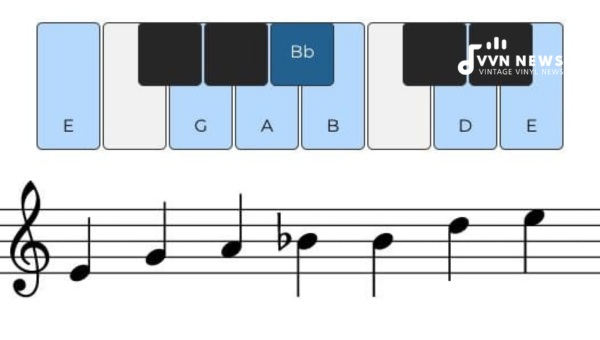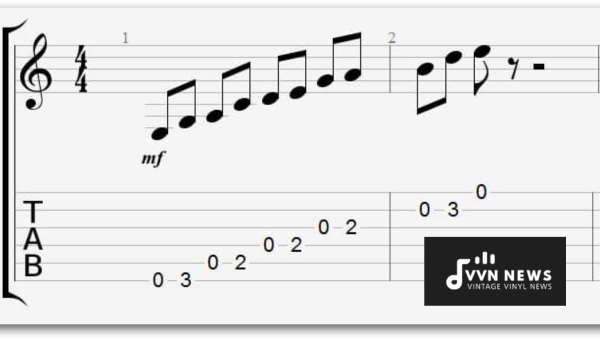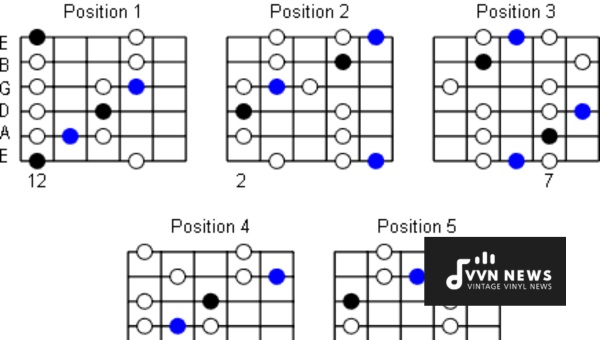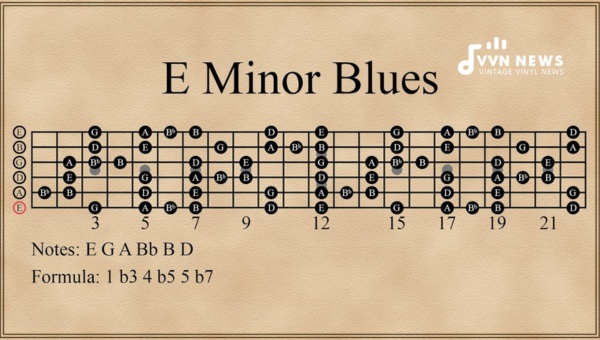As a budding musician, there’s no doubt you’ve come across quite a few musical scales.
One that may have piqued your interest recently is the well-known E minor blues scale.
Without a doubt, this scale possesses a unique blend of tones that can truly elevate your musical interpretation and execution.
The E minor blues scale is beautifully simplistic but offers an array of harmonious notes that form the backbone of many iconic songs.
Whether you play the guitar, flute, piano, or any other musical instrument for that matter, mastering this scale could genuinely amplify your musical repertoire.
Just imagine how gratifying it will feel when you hear the soulful tunes flowing effortlessly from your instrument!
What Constitutes the E Minor Blues Scale?
A blues scale is akin to a rich tapestry, woven from different notes and tones.
Delving into the E Minor Blues Scale, it’s comprised of six distinct notes. These include E – G – A – Bb – B – D.
The addition of the flattened 5th (Bb) breathes life into the scale, gifting it with that quintessential ‘bluesy’ feel.
This additional note truly makes the scale stand out, enhancing its resonance and depth.
Now that you have this essential information at your fingertips, you’re ready to explore more nuanced and intricate details of this unique blues scale!
Constructing the E Minor Blues Scale

Before we embark on constructing the E Minor Blues Scale, we must grasp the basic structure.
The E minor blues scale has six different notes, and their order is E – G – A – A# (or Bb) – B – D.
Step one:
Start with the E natural minor scale. In keynote terms: E – F# – G – A – B – C – D.
Step two:
Now, it’s time to understand the “bluesy” aspect of this scale. From your natural minor scale, you will add a note: A# (Bb).
This is your blue or chromatic note, sprinkling that magic dust on your melody! Your resulting scale should now look like this: E – G – A – Bb (A#) – B – D.
Step three:
Practice! Spend time familiarizing yourself with how each ‘bluesy’ note acts as an embellishment to its adjacent notes.
How does A feel transitioning into Bb? How about from D back to E?
These are your steps to constructing a versatile, soulful sound. Now dive in and make music resonate with that bluesy charm granted by the E Minor Blues Scale.
Also Read: E Flat Minor Blues Scale [Infuse Your Tunes With Moody Blues]
The 5 Positions of the E Minor Blues Scale
The E Minor Blues Scale, also known as the E Pentatonic Blues Scale, is a blend of five notes – E, G, A, Bb (blue note), and D.
But the beauty truly comes alive when you move across the five divisions or ‘positions’ on your instrument.
Whether you are on a guitar fretboard or piano keyboard, these positions will guide your fingers to create that charming bluesy sound echo.
Position 1
This is your starting point when dealing with the E minor blues scale. It initiates from the open low E string.
With this position, you’ll exploit the open strings – a fundamental foundation if you’re keen on establishing that blues than just improvisations.
Don’t be hasty; take your time to master this position with precision before moving forward.
Position 2
Moving to the next position signifies growth. And in this case specifically, it’s all about stretching your fingers further to reach those higher frets on your guitar or notes on your keyboard.
In terms of a guitar, you’re looking at moving up and down between the third and fifth frets.
Position 3
In this third position of our journey within the scale concept, we are halfway there!
This time around, you’ll be focusing not just on slides but hammer-ons and pull-offs here making their first appearance!
These techniques add more ‘flavor’ to your already venomous blues licks.
Position 4
For those committed enough to reach here well done! You’ve come so far! Position four lives in those higher fret zones; we’re talking about seventh and eighth fret territory now.
Here’s where things start amping up with speed but make sure while doing so not to let slip precision which contributed significantly towards reaching this stage in the first place.
Position 5
The ultimate position is marked by the achievement of playing in the double-digit fret territory.
More specifically, you’ll be moving between the tenth and twelfth frets.
This high-end region of your fretboard or keyboard offers those ‘high’ blues tones, creating infectious melody and urgency in your blues play.
These positions are not just placed on a board or keys on a keyboard. They are essential pathways that connect to create a beautiful rendition of music.
Also Read: A Flat Major Blues Scale [Open New Doors In Your Music]
The Relative Minor and Major for the E Minor Blues Scale

To truly embrace the world of musical scales, there’s a need to grasp the concept of relative minor and major.
In this context, let’s delve into the relative minor and major for the E Minor Blues Scale.
So, what does “relative minor” or “relative major” mean? Essentially, these terms describe how every major key has a corresponding minor key (and vice versa) that shares the same notes but from different start points.
The Relative Major for E minor blues scale
In every blues scale, the relative major key is situated three-half steps up from its starting note.
Applying this rule to our pack leader in question, the E minor blues scale, we arrive at G as its relative major.
Despite being two different scales on a surface level, these two scales share identical notes – only differing in their root note.
The Relative Minor for E minor blues scale
On the flip side, identifying a relative minor from a major key involves descending three-half steps from your starting point.
Intriguingly enough, since we are discussing the E Minor Blues Scale as our base entity here, we already have our answer! That’s correct; E itself is its relative minor!
You might ponder about how this knowledge benefits your journey into music.
Well, with an understanding of relative scales comes adaptability in maneuvering through music pieces effortlessly!
Tips for Practicing E Minor Blues Scale with Backing Tracks
Practicing the E Minor Blues Scale (E, G, A, B♭, B, D) with backing tracks can lead to remarkable improvements in your overall musical skills.
They aid in rhythm comprehension and improvisation while making the learning process more gratifying.
Select a Suitable Backing Track
To start, find a well-structured E minor blues backing track. There are a plethora of free backing tracks available online on websites like YouTube and SoundCloud that you can utilize for practice.
Follow the Beat
Once you’ve selected your track, try playing just the basic scale over it. Acclimatize yourself to the tempo and beat of the track.
Accomplish synchronization by actively listening and adjusting your play speed accordingly.
Explore Variation
Don’t limit yourself to just playing straight scale patterns up and down. Add some taste by varying your performance – try skips and jumps between non-adjacent notes for an unpredictable sound.
Familiarize Through Regular Practice
Regular practice is paramount to mastering this scale on any instrument. When consistency meets enthusiasm, you’ll find it easier than ever to hit all the right notes swiftly and accurately.
A solid foundation pays dividends in music, so don’t rush! Be patient with progress as you make this rich sound yours.
Also Read: G Major Blues Scale [Expand Your Harmonic Possibilities]
How does training the ear benefit in understanding the E Minor Blues Scale?

Any musician knows that the key to further enhancing their ‘instrumental’ prowess is rooted in ear training.
This couldn’t be more accurate, especially when learning the E Minor Blues Scale. Let’s dive into why ear training is beneficial.
The Connection Between Ear and Fingers
When you’re endeavoring to master a new scale like the E Minor Blues Scale, being able to replicate that sound into melodies requires translating what your ear hears to precise finger movements.
That’s where ear training comes in handy. It helps bridge the bond between your hearing and finger coordination.
Correct Identification of Tones and Intervals
In a blues scale, there are six different pitches in each octave: E, G, A, Bb, B, and D for E minor blues.
Your ability to differentiate these sounds can be improved with consistent ear training.
By doing so, you’ll be well-equipped to identify where each tone fits on your instrument’s fretboard or keyboard.
Improving Solo Improvisation
Possessing a well-conditioned ear for the minor blues scale opens up satisfying avenues of musical expression during improvisation sessions.
As a result, you can play along with any track effortlessly while composing solos that stay true to the original scale structure.
Ear training strengthens your comprehension of music theory while expanding your musicianship skills!
Recognizable Compositions Utilizing the E Minor Blues Scale
There’s an eclectic mix of songs, across a broad range of genres – blues, rock, and even pop – that seamlessly incorporate the E Minor Blues Scale.
These melodies have captivated audiences throughout the ages with their enchanting rhythms and harmonious blend.
‘For Your Love’ – The Yardbirds
Eric Clapton, a veritable rock icon, was the original guitarist for The Yardbirds.
Their crowd-pleaser ‘For Your Love’ is a brilliant showcase of the E Minor Blues Scale and stands as a testament to Clapton’s finesse with his instrument.
‘Hey Joe’ – Jimi Hendrix
The renowned Jimi Hendrix has delivered some extraordinary tunes using this scale.
His much-loved composition ‘Hey Joe’ immortalizes the E Minor Blues Scale beautifully in every note.
‘The Thrill is Gone’ – B.B. King
On moving towards blues, B.B. King’s signature number ‘The Thrill Is Gone’ brings forth an exceptional interpretation of this scale.
‘Black Magic Woman’ – Fleetwood Mac/Peter Green
Originally written for Fleetwood Mac by Peter Green, ‘Black Magic Woman’ is another masterpiece in which you can hear strains of the E Minor Blues Scale.
Let’s also not forget the numerous pop genre songs that ingeniously weave this enchanting scale into their musical fabric.
Tracks like ΄Billie Jean΄ by Michael Jackson or ΄Superstition΄ by Stevie Wonder manage to capture our imaginations with their stunning renditions using this arresting musical scale.
Listening to these classics can enhance your appreciation for the versatility and beauty that lies within these six simple notes of the E Minor Blues Scale.
These songs could also serve as inspiration for your future compositions.
Also Read: G Flat Major Blues Scale [Unlock Innovative Musical Ideas]
FAQs About The E Minor Blues Scale
What exactly is the E Minor Blues Scale?
The E Minor Blues Scale is a six-note scale that includes the pitches: E, G, A, Bb, B, and D. It’s particularly popular in blues and rock music.
Why should I master the E Minor Blues Scale?
The E Minor Blues Scale can significantly enhance any musician’s repertoire by providing a versatility of soulful tonal variations. It also forms the foundation for many famous musical compositions.
How to play E Minor Blues Scale on a guitar?
To play the E minor blues scale on a guitar start at open position low E string (open), G (third fret), A (fifth fret); move to A string (open), B flat (first fret), and B (second fret).
Can beginners handle learning the E minor blues scale?
Absolutely! The simplicity of the E minor blues scale makes it an excellent starting point for beginners refining their pitch recognition and finger dexterity.
Are any notable songs featuring the E minor blues scale?
Famous songs such as “Crossroads” by Eric Clapton, “Manish Boy” by Muddy Waters, or even “Red House” by Jimi Hendrix all feature the E minor blues scale prominently in their arrangements.
Conclusion
The E Minor Blues Scale possesses a profound versatility that makes it unmissable in your musical journey.
Remember, each scale, including this one, holds a world of potential and serves as more than just a finger exercise for the fretboard.
It encapsulates the style, mood, and flavor of music. Whether you’re strumming the guitar or tickling the ivories on a piano, this scale can add depth and character to your music.
Keep practicing regularly and diligently; perfection comes with time!








